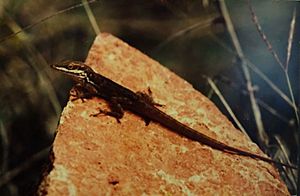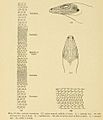Ponce anole facts for kids
Quick facts for kids Ponce anole |
|
|---|---|
 |
|
| Ponce anole (Anolis poncensis), in Ponce, Puerto Rico | |
| Scientific classification | |
| Genus: |
Anolis
|
| Species: |
poncensis
|
| Synonyms | |
|
|
The Ponce anole (scientific name: Anolis poncensis) is a type of lizard. It is also known as the Ponce small-fanned anole or dryland grass anole. In Spanish, it's called lagartijo jardinero del sur.
This lizard belongs to the Dactyloidae family. It is found only in Puerto Rico, meaning it is endemic to the island. It was first discovered in the hills near Ponce. The Puerto Rico Department of Natural and Environmental Resources considers it a "vulnerable species". This means its population is at risk and needs protection.
Contents
What Does the Ponce Anole Look Like?
The Ponce anole has a body that is longer and thinner than other grass anoles. It has a brownish back and greenish sides. Its eyes are blue.
It also has a small white dewlap. A dewlap is a flap of skin under its throat. It uses this dewlap to show off or communicate. The lizard also has a light-colored line on its side. There are several black spots behind its eyes.
Male Ponce anoles can grow up to 44 millimeters (about 1.7 inches) long. Females are a bit smaller, growing up to 40 millimeters (about 1.6 inches).
Where Does the Ponce Anole Live?
This special lizard lives only in Puerto Rico. Its home area is quite small. It is found in the dry and partly dry western part of the island's southern coast.
A scientist named Leonhard Stejneger first found and described this lizard in 1902. He worked at the United States National Museum. He was a curator who studied reptiles and amphibians.
How Did It Get Its Name?
The name poncensis comes from the city of Ponce. This is where the lizard was first found. The suffix "-nsis" is Latin and means "from" or "belonging to" a place.
Leonhard Stejneger published his findings in a book in 1904. The book was titled "The herpetology of Porto Rico."
Images for kids


